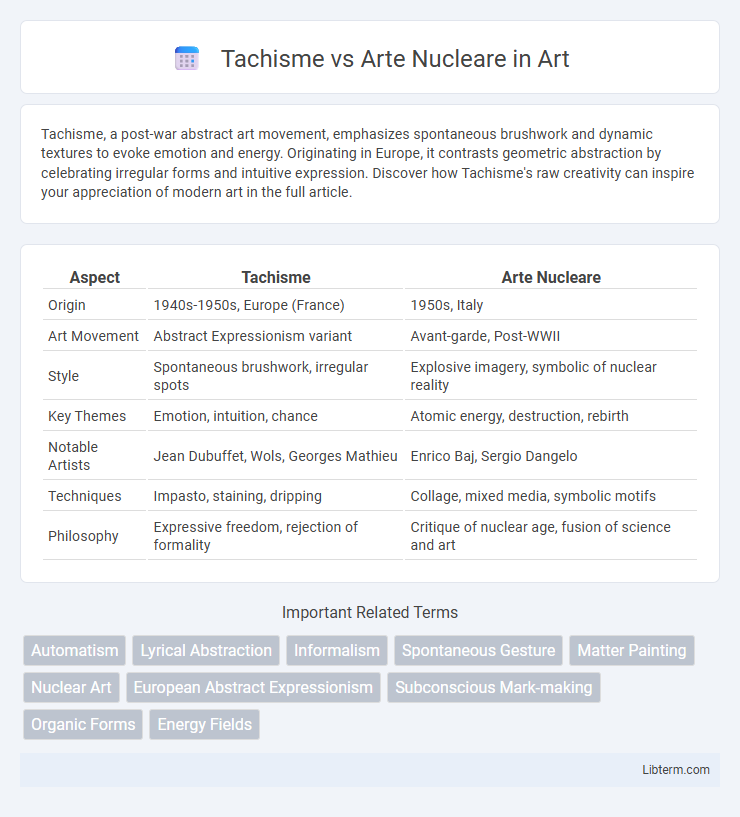Tachisme, a post-war abstract art movement, emphasizes spontaneous brushwork and dynamic textures to evoke emotion and energy. Originating in Europe, it contrasts geometric abstraction by celebrating irregular forms and intuitive expression. Discover how Tachisme's raw creativity can inspire your appreciation of modern art in the full article.
Table of Comparison
| Aspect | Tachisme | Arte Nucleare |
|---|---|---|
| Origin | 1940s-1950s, Europe (France) | 1950s, Italy |
| Art Movement | Abstract Expressionism variant | Avant-garde, Post-WWII |
| Style | Spontaneous brushwork, irregular spots | Explosive imagery, symbolic of nuclear reality |
| Key Themes | Emotion, intuition, chance | Atomic energy, destruction, rebirth |
| Notable Artists | Jean Dubuffet, Wols, Georges Mathieu | Enrico Baj, Sergio Dangelo |
| Techniques | Impasto, staining, dripping | Collage, mixed media, symbolic motifs |
| Philosophy | Expressive freedom, rejection of formality | Critique of nuclear age, fusion of science and art |
Introduction to Tachisme and Arte Nucleare
Tachisme emerged in post-World War II Europe as a spontaneous and expressive form of abstract painting characterized by irregular brushstrokes and a focus on the artist's direct gesture. Arte Nucleare, founded in the early 1950s by Enrico Baj and Sergio Dangelo, combined abstract art with themes related to atomic age anxieties, emphasizing the impact of nuclear technology on society. Both movements challenged traditional artistic conventions but differed in thematic focus, with Tachisme highlighting emotional spontaneity and Arte Nucleare addressing contemporary scientific and political concerns.
Historical Origins and Development
Tachisme emerged in post-World War II France during the 1940s and 1950s as a spontaneous and emotional form of abstract painting emphasizing irregular brushwork and vivid color, closely linked to the European response to American Abstract Expressionism. Arte Nucleare developed in Italy in the early 1950s, led by Enrico Baj and Sergio Dangelo, reflecting anxiety over nuclear weapons and the atomic age by incorporating symbolic and often chaotic imagery to critique contemporary political issues. Both movements arose from the trauma of World War II, with Tachisme focusing on individual expression and Arte Nucleare engaging directly with socio-political themes related to nuclear technology.
Defining Characteristics of Tachisme
Tachisme is characterized by spontaneous brushwork, abstract forms, and a focus on texture and the physical act of painting, emphasizing emotion and individual expression over structured composition. This European movement, emerging in the 1940s and 1950s, contrasts with Arte Nucleare, which incorporates themes of atomic age anxiety and combines figurative elements with symbolic imagery reflecting nuclear destruction. Tachisme's defining traits include gestural strokes, irregular shapes, and an overall improvisational style that prioritizes the subconscious and immediate artistic impulse.
Key Features of Arte Nucleare
Arte Nucleare, emerging in post-World War II Italy, is characterized by its response to nuclear age anxieties, blending abstract expressionism with symbolic references to atomic destruction and human vulnerability. Key features include spontaneous brushwork combined with dark, intense color palettes and often incorporate raw, emotional intensity reflecting existential fears. Unlike Tachisme's emphasis on lyrical abstraction and fluid forms, Arte Nucleare purposefully integrates scientific and catastrophic themes, aligning artistic expression with socio-political commentary on nuclear proliferation.
Influential Artists in Tachisme
Tachisme, a post-war European abstract art movement, is closely associated with influential artists like Jean Dubuffet, Jean-Paul Riopelle, and Pierre Soulages, who emphasized spontaneous brushwork and dynamic textures. These artists contrasted the scientific and political themes of Arte Nucleare, a movement led by Enrico Baj and Sergio Dangelo that explored atomic age anxieties through symbolic imagery. Tachisme's emphasis on emotional expression and organic forms positioned it as a key development in mid-20th century abstract expressionism.
Leading Figures of Arte Nucleare
Arte Nucleare, founded by Enrico Baj and Sergio Dangelo in the early 1950s, sought to confront the chaos and trauma of the atomic age through expressive and symbolic art. Leading figures such as Baj incorporated collage, unconventional materials, and sharp critique of nuclear proliferation, contrasting with Tachisme's focus on spontaneous brushwork and lyrical abstraction exemplified by artists like Jean Dubuffet. Arte Nucleare's fusion of political commentary and experimental techniques positioned it as a pivotal movement addressing post-war anxieties distinct from Tachisme's more introspective and emotive style.
Philosophical and Artistic Influences
Tachisme, rooted in post-war existentialism, embraces spontaneity and the subconscious, emphasizing emotional intensity through abstract forms and gestural brushstrokes influenced by European existential philosophers like Sartre and Merleau-Ponty. Arte Nucleare, emerging in the context of atomic anxiety during the 1950s, reflects a philosophical critique of science and technology's destructive potential, integrating imagery of nuclear physics and chaos to challenge traditional aesthetic values. Both movements reject classical compositional order, yet Tachisme seeks liberation through individual expression while Arte Nucleare confronts societal trauma and the existential threat posed by nuclear proliferation.
Techniques and Materials Used
Tachisme employs spontaneous brushstrokes, drips, and blobs of paint, often using oil or enamel on canvas to emphasize texture and emotional expression. Arte Nucleare incorporates unconventional materials such as metal fragments, ash, and other found objects combined with paint to evoke post-war destruction and atomic age anxiety. Both movements utilize experimental techniques, but Tachisme emphasizes fluidity and spontaneity, while Arte Nucleare centers on material deconstruction and symbolic references to nuclear fallout.
Impact on Contemporary Abstract Art
Tachisme, characterized by spontaneous brushstrokes and organic forms, influenced contemporary abstract art by emphasizing emotional expression and rejecting geometric rigidity. Arte Nucleare introduced themes of destruction and rebirth, integrating political and scientific anxieties into abstract art and provoking a more conceptual and provocative direction. Both movements expanded the boundaries of abstraction, encouraging artists to explore subconscious impulses and societal concerns in their work.
Legacy and Continuing Relevance
Tachisme's legacy lies in its spontaneous brushwork and emotional intensity, influencing contemporary abstract expressionism and street art with its emphasis on individuality and raw creativity. Arte Nucleare's continuing relevance is found in its bold engagement with post-war anxieties, blending artistic innovation with political commentary that resonates in current discussions on nuclear power and existential threats. Both movements contribute enduringly to modern art by challenging traditional aesthetics and reflecting socio-political concerns through abstract forms.
Tachisme Infographic

 libterm.com
libterm.com